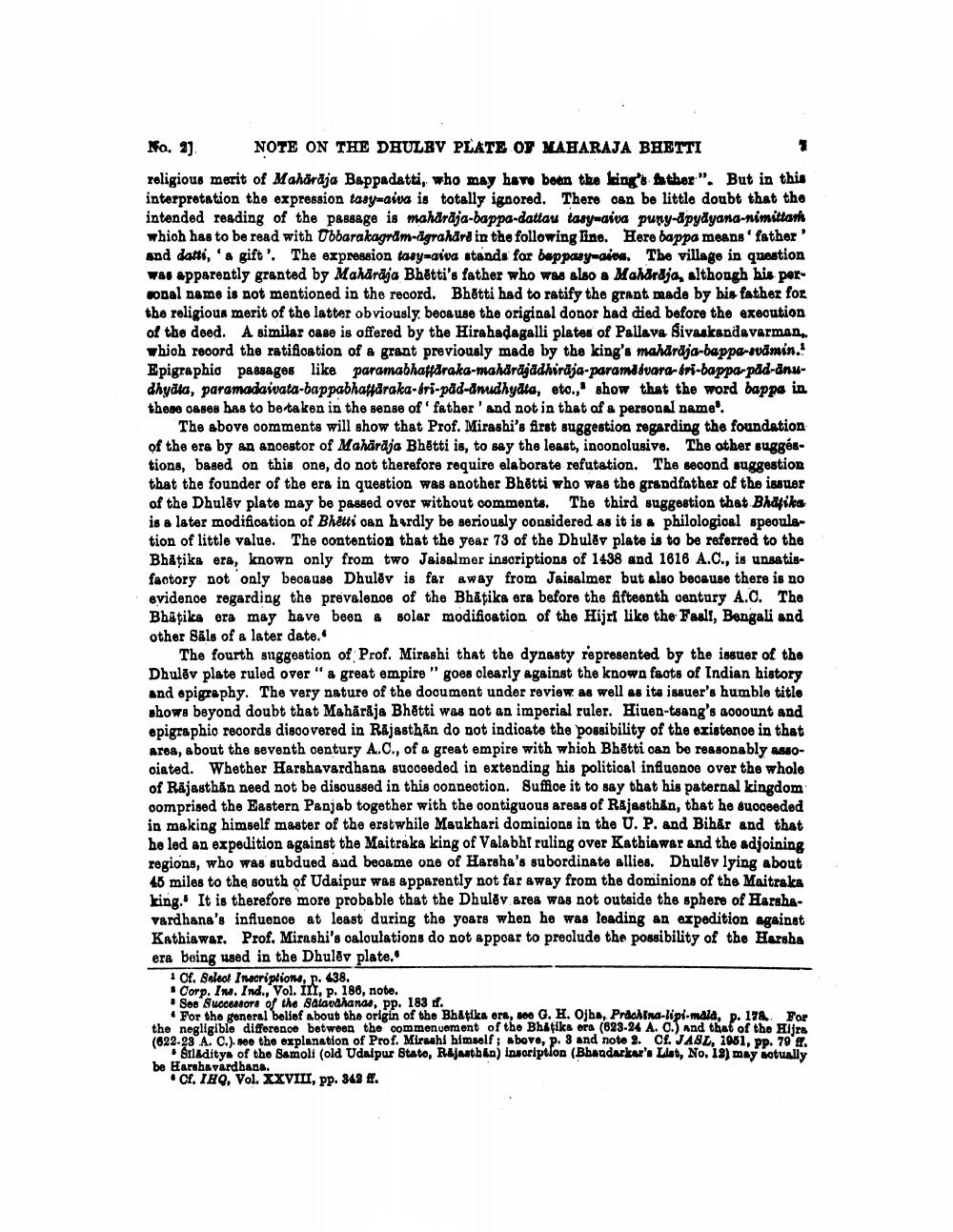________________
No. 2) NOTE ON THE DHULRV PLATE OF MAHARAJA BHETTI religious merit of Mahārāja Bappadatti, who may have been the king's father". But in this interpretation the expression tasy=aiva is totally ignored. There can be little doubt that the intended reading of the paggage is maharaja-bappa-dattau tasyaiva puny-dpydyana-nimittarh which has to be read with Ubbarakagrdm-igrahard in the following line. Here bappa means' father' and datti, ' a gift'. The expression taey=aiva stands for bappasy-aids. The village in question was apparently granted by Maharaja Bhatti's father who was also a Maharają, althongh his pervonal name is not mentioned in the record. Bhatti had to ratify the grant made by his father for the religious merit of the latter obviously, because the original donor had died before the execution of the deed. A similar case is offered by the Hirahadagalli plates of Pallava Sivaskandaverman, which record the ratification of a grant previously made by the king's maharaja-bappe-samin.! Epigraphic passages like paramabhaffdraka-maharajadhiraja-paramddvara-tri-bappa-padd-anudhyāta, paramadaivata-bappabhaffäraka-fri-pad-dnudhydta, eto.,' show that the word bappa in these osses bas to be taken in the sense of' father and not in that of a personal name'.
The above comments will show that Prof. Mirashi's first suggestion regarding the foundation of the era by an ancestor of Mahārāja Bhetti is, to say the least, inoonolusive. The other suggéstions, based on this one, do not therefore require elaborate refutation. The second suggestion that the founder of the era in question was another Bhetti who was the grandfather of the issuer of the Dhulēv plate may be passed over without comments. The third suggestion that Bhafika is a later modification of Bheui oan hardly be seriously considered as it is a philologioal speouls. tion of little value. The contention that the year 73 of the Dhuldv plate is to be reforred to the Bhatika era, known only from two Jaisalmer inscriptions of 1438 and 1616 A.C., is unsatisfactory not only because Dhulēv is far away from Jaisalmer but also because there is no evidence regarding the prevalence of the Bhåţika era before the fifteenth century A.C. The Bhäţika era may have been & solar modification of the Hijrt like the Faall, Bengali and other Bäls of a later date.
The fourth suggestion of Prof. Miraghi that the dynasty represented by the issuer of the Dhulov plate ruled over " a great empire" goes clearly against the known facts of Indian history and epigraphy. The very nature of the document under review. as well as its issuer's humble title shows beyond doubt that Maharaja Bhetti was not an imperial ruler. Hiuen-tsang's account and epigraphic records discovered in Rajasthan do not indicate the possibility of the existence in that Area, about the seventh century A.C., of a great empire with which Bhatti oan be reasonably 4880oiated. Whether Harshavardhana succeeded in extending his political influence over the whole of Rajasthan need not be disoussed in this connection. Suffioe it to say that his paternal kingdom oomprised the Eastern Panjab together with the contiguous areas of Rajasthăn, that he succeeded in making himself master of the erstwhile Maukhari dominions in the U. P. and Bihar and that he led an expedition against the Maitraka king of Valabhi ruling over Kathiawar and the adjoining regions, who was subdued and became one of Harsha's subordinate allies. Dhulēv lying about 45 miles to the south of Udaipur was apparently not far away from the dominions of the Maitraka king. It is therefore more probable that the Dhulėv area was not outside the sphere of Harshavardhana's influence at least during the yoars when he was leading an expedition against Kathiawar. Prof. Mirashi's caloulations do not appoar to preclude the possibility of the Harsha era being used in the Dhulev plate.
1 Cf. Ssloot Inscriptions, p. 438. • Corp. Ins. Ind., Vol. III, p. 186, note. . See Successors of the salavahanda, pp. 183 f.
* For the general belief about the origin of the Bhatika ere, 100 G. H. Ojba, Prdchina-lipi-mala, p. 178. For the negligible difference between the commencement of the Bhatika era (623-24 A. C.) and that of the Hijra (622-23 A. C.). see the explanation of Prof. Mirashi himself; above, p. 8 and note 2. Cf. JASL, 1961, pp. 79 8.
Siladitya of the Samoli (old Udaipur Stato, Rajasthan) insoription (Bhandarkar'List, No. 18) may actually be Harshavardhana.
. Cf. IHQ, Vol. XXVIII, pp. 843 #.




